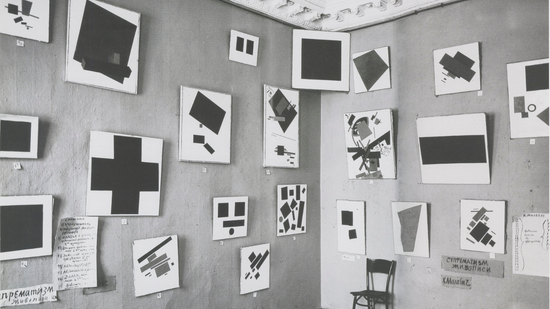
Suprematism vs Constructivism
At the beginning of the 20th century, the Russian vanguards developed, which ended up having a notable impact on European artistic movements. The climate of political stability in Russia, but also openness after 1905, allowed the emergence of new ideas. Influenced by Cézanne and the avant-garde movements in Europe, we saw the birth of two new artistic styles, Suprematism and Constructivism.

What was Suprematism?“The supremacy of pure sensibility in the figurative arts”
In 1915, the painter Malevitch, in collaboration with the poet Vladimir Maiokovsky, published the Suprematist Manifesto. He defended the idea of an autonomous art, which focused on its potential and had no intention of imitating reality. In the same year, Malevitch presented 39 non-objective works at the 0.10 Exhibition, consisting of geometric, monochromatic figures on white backgrounds that did not relate to the objective or real world. From this exhibition, Malaitch highlighted the monochrome painting, “Black square on white background”, by placing this work in the space established in the culture orthodox to religious images (Virgin Mary). These works renounced the interpretation of ideas or emotions, and intended to subject painting to a thematic purity and expressive means. This new form of pure abstraction, totally non-descriptive, influenced several artists and art movements during the 20th century. An example of this is abstract art, abstract expressinism, minimalism, conceptual art, among others.
Throughout his career, Malevich always sought to create pure compositions, devoid of all sensuality, and stated that the external appearances of nature had no interest for him, the essential was sensitivity, free from the impurities that involved the representation of the object, more than than that, which involved the very perception of the object.

What was Constructivism?
Contrary to what happened in the rest of Europe, Russia's exit from the First World War (1914-1918) and the Russian Revolution in 1917 led to the development of artistic activities and the active participation of artists in the reorganization of the country. In 1918, in order to intensify political propaganda, Lenin proposed the construction of monuments to war heroes. Thus, constructivism emerged, a movement that intended to place artistic creation at the service of society, by supporting technology. The term comes from a catalog where it was stated that “all artists must be workers, the factory is the place where true life is created and built”. For the constructivists, art should be linked to factory production, industry and the new social and political order that was living in Russia. In this way, the new artist had to abandon the merely contemplative bourgeois concepts of the fine arts and transform himself into an active artist who intervenes in the social context and in industrial production. In 1919, Vladimir Tatlin conceived the “Monument to the Third International”, a building 400 meters high, which combined sculpture and architecture but also the idea of art at service. However, this project was never built. On the other hand, there were more graphic artistic expressions, such as propaganda posters, with realistic figures in geometric constructions of great austerity, by Aleksandr Rodchenko.

From 1919, Constructivism had the support of the Communist Party, however, in the following years, those responsible for the movement found themselves divergent in relation to their political stance. One part of the group maintained that artists should maintain a personal involvement with the creative process, while the other part defended that artists were “intellectual workers” and, therefore, they should work from that point of view. At this point, many artists left Russia, in order to find a space where they could have a personal involvement with their creation. Meanwhile, others put their artistic creations at the service of the economic and political demands of the country where they stayed. Although this movement started in Russia, it ended up spreading to other European countries, mainly Germany. It lasted until the mid-1930s, when it was replaced by socialist realism. Constructivism had a profound influence on modern art and modern design, such as De Stijl and Bauhaus.

